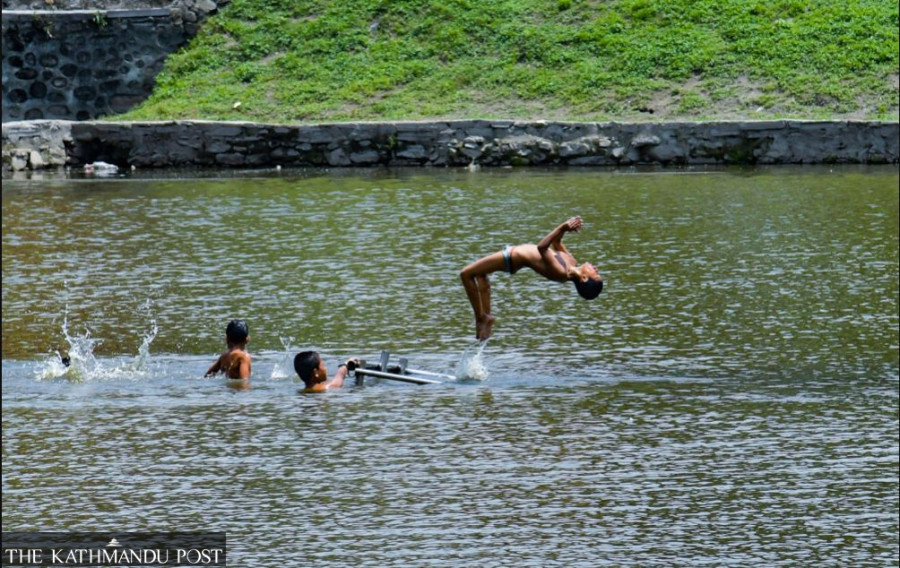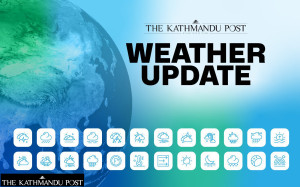Weather
Valley sizzles as temperature persists over 30 degrees
Kathmandu’s temperature climbed to 34.3 degrees Celsius on Wednesday. Changunarayan of Bhaktapur, Chautara of Sindhupalchok, Tikapur of Kailali, Dharan of Sunsari, and Sarlahi break heat records this year.
Arjun Poudel
Most districts, especially in the hills and Tarai, have been sweltering under extreme heat for the last several days, with temperatures soaring up to 45 degrees Celsius. However, the districts of Koshi province have been spared from this scorching weather.
Several weather stations, including those at Changunarayan Bhaktapur, Chautara of Sindhupalchok, Tikapur of Kailali, Dharan of Sunsari, and Sarlahi, broke all previous records of maximum temperatures this year.
Temperatures exceeding 33 degrees Celsius over the past several days have made life difficult in the Kathmandu valley, with many residents complaining about the heat.
On Wednesday, the temperature climbed to 34.3 degrees Celsius in Kathmandu.
Met officials said that hot and dry conditions will continue for the next couple of days, as monsoon rains are not expected to arrive in the Valley anytime soon.
“Monsoon rain is a must for the Valley to cool down, but it is unlikely to arrive in the next two days,” said Pratibha Manandhar, a senior meteorologist at the Meteorological Forecasting Division. “Temperatures above 30 degrees Celsius for several days have made the Valley hotter.”
According to the Met Department data, the weather station at Changunarayan in Bhaktapur recorded 34.4 degrees Celsius on May 31, the highest temperature ever recorded here. Kathmandu had recorded 36.6 degrees Celsius on May 7, 1989.
Tikapur of Kailali recorded 45.2 degrees Celsius on May 30, the highest temperature in the country this year. Likewise, Dharan recorded 40 degrees Celsius on April 28, and Sarlahi recorded 43 degrees Celsius; both are the highest temperatures recorded for those places, according to the Met department.
Monsoon clouds entered the country from eastern Nepal on Monday, three days ahead of the usual onset date. Since then, districts of eastern Nepal have been witnessing rainfall.
Met officials say it used to take two days for the monsoon clouds to arrive in the Valley after their arrival in eastern Nepal and around a week to spread throughout the country. However, last year, it took some three weeks for rainfall to occur in western and far-western Nepal.
“Due to climate change, the weather has become more unpredictable,” said Manandhar. “The monsoon that entered eastern Nepal two days ago should have reached the Valley by Wednesday, but it may take a few more days.”
The Met Office issued a heat wave warning for western and farwestern Tarai following the onset of monsoon. Officials said that they may have to issue more such warnings in the coming days due to the slow progression of the monsoon towards the western parts of the country.
“It is not possible to come out in the afternoon due to the extreme heatwave conditions,” Dr Sanket Kumar Risal, information officer at Bheri Hospital in Nepalgunj, told the Post over the phone. “The hospital is also packed with patients suffering from fever and water-borne diseases. Even groundwater sources are shrinking in our areas. It now takes several hours for the water tank to fill up, which previously took just an hour.”
On Wednesday Dhangadhi recorded 43.9 degrees Celsius, followed by Nepalgunj (42.2°C), Birendranagar (41.1 °C), Bhairahawa (40.4 °C), Ghorahi (39.5°C), and Dipayal (40.8 °C).
The monsoon season in Nepal generally begins on June 13 and ends on September 23. Last year, it started on June 14, one day later than the normal onset day.
A normal monsoon, supported by the timely arrival of rain, translates into favourable agricultural production, mainly of paddy, and is further linked with the country’s overall economic growth.
The monsoon season, which delivers around 80 percent of the country’s total annual rainfall, generally lasts 105 days. But, in recent years, it has been taking more time to withdraw.
The Met Office has forecast above-normal rains and above-average maximum and minimum temperatures this monsoon, which could unleash extreme weather events, such as flooding, inundation, and landslides.
The department’s climate section has forecast weather conditions for four months (June to September). It said most parts of the country are likely to experience above-average minimum and maximum temperatures and rainfall due to weakened El Nino conditions, and the development of La Nina conditions.
El Nino conditions are the climatic patterns in which the surface water warms, unusually.
The opposite, the cooling of the ocean surface, happens in the La Nina conditions.
Nepal is one of the world’s most vulnerable countries to the climate crisis and has witnessed multiple extreme weather events over the past decade and a half.
Evidence suggests the maximum temperature in Nepal is rising faster, at 0.056 degrees Celsius a year, compared to the global average of a rise of 0.03 degrees Celsius a year.
Experts say extreme weather events—excessive rainfall in a short time, continuous rain for several days post-monsoon, dry spells and droughts, below-average precipitation, and above-normal temperatures in winter—have become more frequent in Nepal.




 12.12°C Kathmandu
12.12°C Kathmandu






